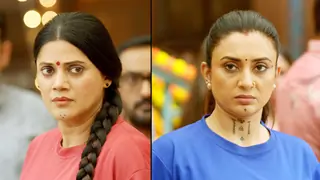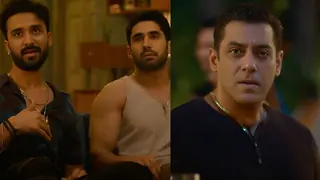Bindusara (r. c. 320-273 BCE) was the second emperor of the Maurya Empire. During his reign, the empire expanded southwards. He had two well-known sons, Susima and Ashoka, who were the viceroys of Taxila and Ujjain, respectively. The Greeks called him Amitrochates or Allitrochades - the Greek transliteration for the Sanskrit word Amitraghata"Slayer of enemies". He was also called Ajatashatru "Man with no enemies" in Sanskrit (not to be confused withAjatashatru, son of Bimbisara, who ruled Haryanka Magadha from 491-461 BCE).
Bindusara, just 22 years old, inherited a large empire that consisted of what is now the northern, central and eastern parts of India along with parts of Afghanistan and Balochistan. Bindusara extended this empire to South India as far as modern Karnataka. He brought sixteen states under the Mauryan Empire and thus conquered almost all of the Indian peninsula (he is said to have conquered the "land between the two seas" - the peninsular region between the Bay of Bengal and the Arabian Sea). Bindusara didn't conquer the Dravidian kingdoms of the Chola dynasty, ruled by KingIlamcetcenni[citation needed], the Pandyan dynasty and the Chera dynasty. Kalinga (modern Odisha) was the only kingdom outside of South India that didn't form part of Bindusara's empire. It was later conquered by his son Ashoka, who served as the viceroy of Ujjain during his father's reign.
According to a legend, Chandragupta, though fond of his son, believed that he would never be a great king as he never learned to love anything passionately, whether be it any of his wives or religion or the empire itself.
Bindusara's life has not been documented as well as that of his father Chandragupta or of his son Ashoka. Chanakya continued to serve as prime minister during his reign. According to the medieval Tibetan scholar Taranatha who visited India, Chanakya helped Bindusara "to destroy the nobles and kings of the sixteen kingdoms and thus to become absolute master of the territory between the eastern and western oceans." The Divyavadana gives the story of a revolt in Taxila and the dispatch of the crown-prince Ashoka to quell it. The people of city received him with ovation by declaring that they were not opposed either to prince or to Bindusara but to the wicked officials who practiced oppression over them.
Ambassadors from the Seleucid Empire (such as Deimachus) and Egypt visited his courts. He maintained good relations with the Hellenic World.

Bindusara renounced his throne in favour of his son Ashoka in 272 BCE (some records say 268 BCE) and went to do penance.
Religion
Bindusara's guru Pingalavatsa (alias Janasana) was a Brahmin of Ajivika sect follower of Makkhali Gosala jvika. One of Bindusara's Queens, Subhadrangi, was a Brahmin also of the Ajivika sect from Champa (present Bhagalpur district).]Bindusara is accredited with giving several grants to Brahmin monasteries (Brahmana-bhatto).[14]
Empire
Bindusara extended his empire further as far as south Mysore. He conquered sixteen states and extended the empire from sea to sea. The empire included the whole of India except the region of Kalinga (modern Orissa) and the Tamil kingdoms of the south. Kalinga was conquered by Bindusara's son Ashoka.
Early Tamil poets speak of Mauryan chariots thundering across the land, their white pennants brilliant in the sunshine. Bindusara campaigned in the Deccan, extending the Mauryan empire in the peninsula to as far as Mysore. He is said to have conquered 'the land between the two seas', presumably the Arabian sea and the Bay of Bengal. It is also possible he conquered the Tamil Kingdoms as they were also the land between two seas.
Administration during Bindusara's Reign
Bindusara maintained good relations with Seleucus I Nicator and the emperors regularly exchanged ambassadors and presents. He also maintained the friendly relations with the Hellenic West established by his father. Ambassadors from Syria and Egypt lived at Bindusara's court.
Tradition had it that he had a friendly relationship with Antiochus I Soter and asked him to send him some sweet wine, dried figs and a sophist:
| " | But dried figs were so very much sought after by all men (for really, as Aristophanes says, There's really nothing nicer than dried figs), that even Amitrochates, the king of the Indians, wrote to Antiochus, entreating him (it is Hegesander from Delphi who tells this story) to buy and send him some sweet wine, and some dried figs, and a sophist; and that Antiochus wrote to him in answer, "The dry figs and the sweet wine we will send you; but it is not lawful for a sophist to be sold in Greece." Athenaeus, Deipnosophistae XIV.67Family Life - He had 16 Wives and 8 SonsIt is said that Bindusara had 16 wives. Also, one can only assume that he had 8 sons because according to a Tibetan writer Tarantha Ashoka killed his 6 brothers to get to the throne and spared one who later went on to become his Uparaja or deputy king. Ashoka was born to Bindusar's wife Dharma in 304 BCE while Mahan Samrat Chandragupt died in 298 BCE, this makes it obvious that Bindusar married almost all his main wives including Dharma before the death of Chandragupta Maurya. Sushim was elder to Ashoka. Later when Bindusar turned 22 and Chandragupt decided to retire Samrat Bindusar became the next Samrat. The Last days - When Bindusara Died Before Appointing His HeirSamrat Bindusar died in 272 BCE when he was only 48 years old. The Sinhalese texts mention that he died due to the fratricidal war that took place between the brothers. However, other texts mention that he died before the war took place. There were two sides in this war, one was headed by Ashoka and other was led by Sushima. It is said that though Bindusar always wanted his elder son Susima to become the next Samrat, the same was not favored by the Brahims whom Sushim often insulted. These Brahmins supported Ashoka, the son of a queen of lower status but who belonged to the Ajivika sect. This is how Ashoka became the next heir though he was not the original choice of Samrat Bindusar. | " |






















